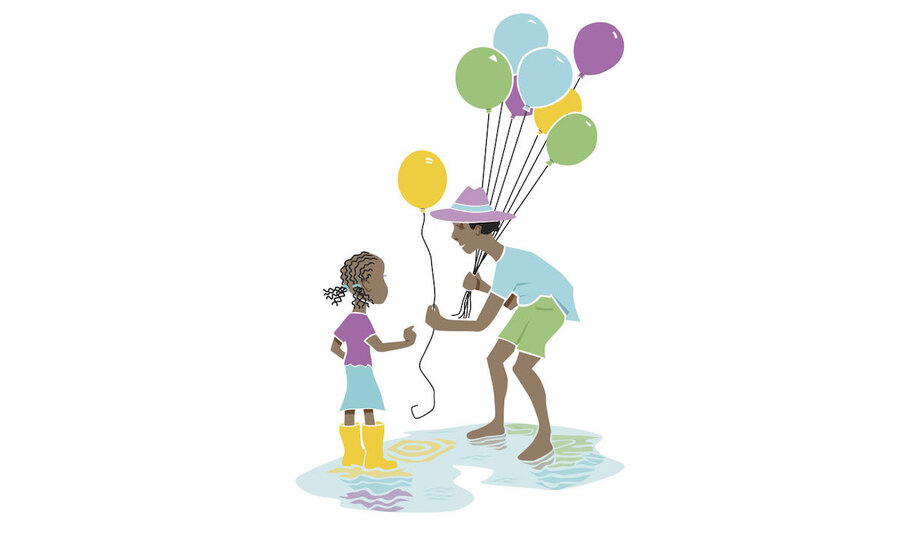The day I heard poetry call
Loading...
I am in seventh-grade language arts class in an upstairs room in the old red-brick junior high school building. The afternoon sun streams through high windows that face onto the playground and athletic fields. It is the day I remember hearing this phrase for the first time: “the little/ lame balloonman.”
It’s from “In Just-,” the E.E. Cummings poem we are reading in our anthology. Mr. Katz is trying to loosen up our adolescent imaginations to the point where we might appreciate figurative language. Why are “eddieandbill ... running from marbles and/ piracies”? It’s not, evidently, a spelling or grammar question.
Then along comes another phrase: “the world is mud/ -lucious,” then “puddle-wonderful,” and “bettyandisbel come dancing/ from hop-scotch and jump-rope.” Something begins to blossom in me as a reader: the melding of descriptive words and words embodying action.
Words could be and do what they describe! The April day effortlessly bespoke the poem, and the poem bespoke the day. I’d like to think Mr. Katz was conspiring with the poem, sun, spring, and kid energy, not just a lesson plan. From then on, I was a new reader and writer. I look back on that poem as a starting line.
I heard the call to poetry.
I would see “In Just-” in practically every subsequent anthology in my language arts life. It was in my dog-eared “A Pocket Book of Modern Verse,” edited by Oscar Williams (high school); in “An Approach to Poetry,” by Wayne Shumaker (college); “An Introduction to Poetry,” by X.J. Kennedy (teaching); and in “The Language of Spring: Poems for the Season of Renewal,” which I just acquired. It is not included in “The Oxford Book of American Poetry.” Pity. They all reside on my shelves, a chronology of anthologies, a syllabus of my reading life.
I began to understand that a poet is describing the world, experience, or concepts in a way that antidotes dullness, commonness, and indifference; that stretches the possibilities of language; that sings and beckons. A poem is a discrete vessel of clarity and understanding. “Poetry provides the one permissible way of saying one thing and meaning another,” Robert Frost explained. And poems of all eras live in a kind of simultaneity in their anthologized universes.
Reading poems became a daily practice. I collect them, anthologizing my own favorite expressions of life’s joys and tribulations – the record of the thoughts, feelings, and experiences of the most capable commentators on how to sail any waters. I’m fond of Billy Collins’ view: “The history of poetry is the only surviving history we have of human emotion. It is the history of the human heart. There is no other one. Without poetry, we’d be deprived of the emotional companionship of our ancestors.”
As bipeds, we walk in iambs. The four chambers of our heart cannot help giving us the tempo of a 4/4 march. We are intrinsically called to poetry.
The decades of my teaching career burgeoned my personal anthology with the poems I taught or that have taught me, the ones I shared or were shared with me, the ones that have given me the insight, love, truth, and beauty of which poetry is uniquely capable. My criteria: poems that are instantaneously valuable or impressive; poems that sound good, feel good, or go swiftly into one’s mental hip pocket. I link poems to distinct times and places, people or experiences: an inspiring or mirthful thought, a heartbreak or infatuation. I have an almanac of readings. My collection of poetry is an emotional companion to my life.
The special ones lead back to an inaugural memory of a sunny classroom in junior high school when Mr. Katz carefully broached new territory – a moment that suspended my preoccupation with middle school mundanity. The dance on Friday, my drum lesson on Wednesday afternoon, and even Caroline’s beguiling ponytail yielded. I was smitten with a poem. The “goat footed/ balloonMan,” as Cummings wrote it, still “whistles/ far/ and/ wee,” makes the world “mud-lucious” again and again, making spring a poetic rite. And every time, I come running.








